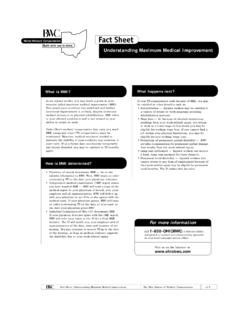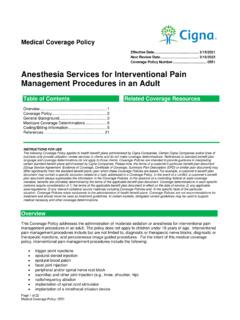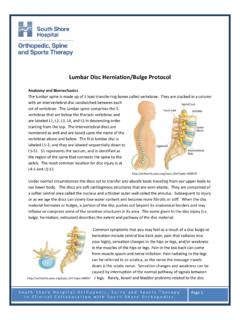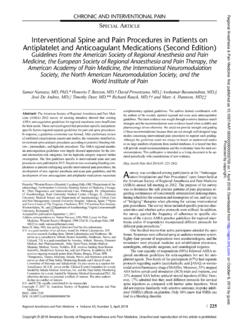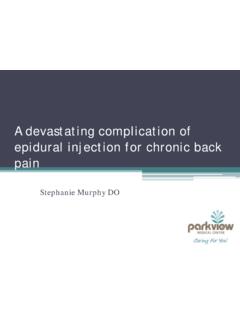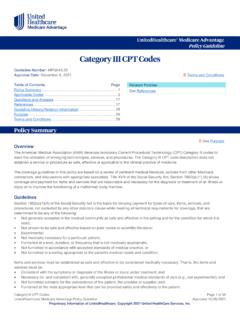Transcription of Epidural Steroid Injections and Medial Branch Blocks
1 1 BackgroundBWC s Medical & Health Division presents the following crosswalks to help clarify various nuances when performing Epidural Steroid injection procedures and Medial Branch Blocks on our injured workers. The goal is to address the differences that exist among stakeholders in submitting for authorization, procedural approval, and to understand appropriate utilization of these procedures. To help facilitate treatment and ease some of the administrative burdens among the various parties involved, we designed these crosswalks to help improve the quality of care and timeliness of treatment for our injured workers. Our intent was to help align the BWC staff, managed care organizations (MCOs) and providers with the proper procedure that should take place and help streamline the process.
2 Over the years, the Medical & Health Division fielded questions from providers, MCOs and BWC staff alike as to why we ask for this procedure, what levels should be considered or included, why the requests did not align with Official Disability Guidelines and why we deny procedures. This is just to name a few of the questions. The crosswalks were presented to the Health Care Quality Assurance Advisory Committee (HCQAAC) members meet-ing on Aug. 10, 2016. The HCQAAC approved unanimously both crosswalks. Our hope in publishing these crosswalks is to help improve efficiency, minimize delays in care and decrease the Alternative Dispute Resolution process among BWC staff, MCOs and providers.
3 What is an Epidural Steroid injection? An Epidural Steroid injection is an outpatient procedure that can help relieve neck, back, limb and/or other pain caused by irritated (inflamed) spinal nerves. The provider delivers the medications to the spinal nerve. They act to reduce the inflammation of those nerves and nearby discs, which is often the source of are three ways to deliver Epidural Steroid Injections : Interlaminar, transforaminal or caudal approaches. The best method depends on the location and source of pain. See Table A and B on pages 2 and levels and authorization requests The provider usually injects the medication at the affected level allowed in the claim unless stenosis, prior surgery, or other patho-anatomy limits access to perform the injection safely.
4 In cases of limited access, physicians may need to take an approach 1-2 levels inferior to the level allowed in the claim. This approach generally achieves the same outcome because medications typically flow upward several considering the injection level, the goal is to focus the disposition of the medication as close to the affected level as pos-sible and in the safest manner possible. This is a judgment call for the physician who must have flexibility to do a safe procedure. Epidural Steroid Injections and Medial Branch Blocks Continued on next pageEpidural Steroid Injections Interlaminar and transforaminal approaches Fact sheet April 20172 Interlaminar Epidural Steroid InjectionsTable A: Spine level pearls Providers usually do thoracic and lumbar Injections at the allowed level in the claim unless stenosis, prior surgery, or other pathoanatomy limits access to perform safely the injection.
5 In those cases, the physician may need to approach: At position 1 or 2 levels inferior to the allowed level; or With a caudal injection if there is a lower lumbar condition present; or With a transforaminal Epidural Steroid injection at the allowed level and/or next inferior levels. (SEE: Table B.) All options are acceptable and should be Injections : C7-T1 is the preferred level for injection due to the larger size of the canal and the consistent configuration of the ligamentum flavum. Although risk increases at levels above C7-T1, those levels may still be a viable and necessary option. Alternatively, physicians may need to target the T1-2 level, due to stenosis, prior surgery or other pathoanatomy that limits access at Continued on next page Fact sheet April 20173C1C2C2C2C3C3C4C3C4C4C5C4C5C5C6C5C6C 6C7C6C7C7C8C7T1C8T1T1T2T1T2T2T3T2T3T3T4T 3T4T4T5T4T5T5T6T5T6T6T7T6T7T7T8T7T8T8T9T 8T9T9T10T9T10T10T 11T10T 11T 11T12T 11T12T12L1T12L1L1L2L1L2L2L3L2L3L3L4L3L4L 4L5L4L5L5S1L5S1S1S2S1*S2 Transforaminal Epidural Steroid Injection (Selective Nerve Root Block SNRB)Table B: Crosswalk between level of spine and injection targets NOTE.
6 An SNRB is a type of transforaminal Epidural injection that physicians can use for diagnostic pur-poses in determining/verifying a particular spinal nerve root as a pain generator. The injection typically includes a small volume of local anesthetic. Some interventionalists will also include Steroid in attempt to provide a sustained therapeutic effect in the same setting rather than bringing the patient back later for a therapeutic injection.*S2 transforaminal Epidural Injections are uncom-mon. Usually, a provider takes a caudal approach if access is limited at S1-S2 on next pageDisc level allowed in claimNerve Root Level USUALN erve Root Level ALTERNATIVEAPPROPRIATE TREATMENT 4 Continued on next pageWhat is a Medial Branch block injection?
7 Physicians commonly use this type of injection to help diagnose and treat spine pain. This procedure disrupts the flow of pain messages between the facet joints and the brain for a temporary period. The procedure involves the injection of a local anesthetic along the small Medial nerve branches that feed a particular facet joint. Two Medial branches supply each facet joint. This usage of Medial Branch Blocks is primarily a diagnostic tool to identify the source of neck or back pain. It s not intended to provide long-term relief of symptoms. Physicians perform the procedure with a low-volume local anes-thetic of less than Steroids should not be used in this procedure since they can skew the diagnostic aspects.
8 If documented patient-generated pain relief occurs following a Medial Branch block, the physician can make a diagnosis of facet joint pain. A pain diary is the appropriate tool for such documentation. (See attached Pain Dairy form.)Once diagnostic Medial Branch Blocks identify and confirm the affected areas, the physician may consider the injured worker a candidate for nerve ablation procedures to provide prolonged relief. What is nerve ablation?The destruction of nerves is a method physicians use to reduce certain kinds of pain by preventing transmission of pain signals between a specific Medial Branch and the brain. A physician uses this procedure to destroy a portion of nerve tissue to cause an interruption in pain signals and reduce pain in that area.
9 Radiofrequency ablation is a common nerve destruction technique with demonstrated safety and efficacy. Because it involves nerves, we often call it radiofre-quency neurotomy. Nerve destruction Blocks pain signals from traveling to the brain. However, the nerves grow back. Therefore, the results are typically temporary, and may last for six to 24 levels and authorization requestsDue to typical spinal anatomy, there may not be a direct correlation between the initial allowance in the claim, the relevant Branch numbering and spinal numbering to which the physician is directing the treatment. For example, if the allowance in the claim is for the C5/C6 joint, then the C5 and C6 Medial nerve branches are the appropriate targets while an L4/L5 joint would involve the L3 and L4 Medial nerve branches.
10 (See Table 1 to cross-reference appropriate levels) Many providers are accustomed to requesting authorization for two Blocks . This approach will generally result in the need for additional medical support, given Official Disability Guidelines reflect one block as the standard of diagnosis and treatment. Therefore, when a provider submits a Physician s Request for Medical Service or Recommendation for Additional Conditions for Industrial Injury or Occupational Disease (C-9) for two Blocks , and there is insufficient medi-cal documentation to support the request, the managed care organization (MCO) should pend the request and seek additional medical documentation through the Request for Additional Medical Documentation for C-9 (C-9-A.)

